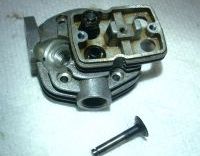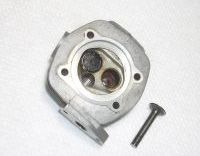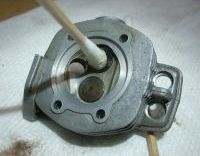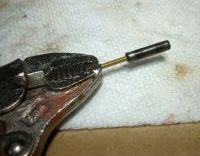t.jpg) |
t.jpg) |
| OS FS-20 4-Stroke Model Engine | |
OS FS-20 Restoration
by Tom Fey
Published 6 Apr 2024; Revised 7 Jun 2024
Disassembly
A new bearing set was $8 and I got to take it all apart. I polished the stems lighty, then lapped in the valves with polishing compound and a q-tip hot glued to the valve. All fun for me.
The cylinder casting is one piece with the crankcase, so you slide the top-hat cylinder sleeve out, then simply remove the free-floating wrist pin, remove the piston, then remove the rod, says the Internet. Ya, right. Since the wrist pin is free-floating, it is protected/centered at each end by a minute, removable, top-hat shaped Teflon plug pressed in at each end. There is a center hole in the Teflon plug where you insert a pin or tiny screw and hopefully get sufficient grip to withdraw the wrist pin. I was not so lucky. The wrist pin would only withdraw 2 mm and there is nothing to grab it with. I tried taps, split brass shims, wood shims, wavy brass rods, etc. I finally necked down a brass 2-56 screw, cleaned everything with alcohol, and then used JB Weld to glue the screw into the wrist pin bore. A vice grip and my right arm did the rest. It took a good tug. Then I back drilled the pin from the other side to remove the screw and epoxy. It was a satisfying and necessary victory. Minimal polishing returned the wrist pinto free floating.
Reassembly
Freezing the crankshaft and baking the crankcase to 350°F made for easy insertion of the new bearings onto the crank and into the crankcase. The machining on this little engine is out of this world. It is mostly back together now. I'll run it (9 x 5 prop; ± 11,000 rpm; 0.3 hp) for yucks, clean it, flush it, oil it, and put it on the shelf.
How 2-stroke oil gets to the lower end is, I assume, by blow-by. The valve stems get lubed by the fuel both in and out. How oil gets up to the rocker arms is still a mystery. When I spin the engine over by hand I can hear wheezing and clanking of the valves, but compression is relatively unimpressive, flow volumes are small, and I'm not used to the power it takes to actuate valves. It'll be interesting to see how it runs and feels when warm. I won't fly this engine.
I got to thinking about the valve timing, phase durations, etc., so I put together some diagrams based on info provided in a Clarence Lee article. Pretty fascinating, but I guess the large valve overlap makes sense in an engine that is happiest at 10,000 rpm.
Speaking of which, here is a YouTube video of my engine running. |
 |
 |
 |
 |
| Rocker Box and Valve | Head and Valve | Lapping the Valve | Piston Pin Removal | Victory! |
By the way, there are a number of videos on YouTube describing the disassembly and reassembly of this type of engine, but larger versions than mine. (OS FS-70 of 0.7 in³ and OS FS-40 of 0.4 in³).